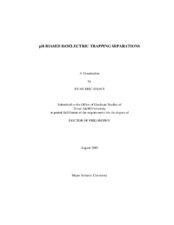| dc.description.abstract | The classical isoelectric trapping (IET) technique, using the multicompartment
electrolyzer (MCE), has been one of the most successful electrophoretic techniques in
preparative-scale protein separations. IET is capable of achieving high resolution
discrimination of proteins, by isolating proteins in between buffering membranes, in
their isoelectric state. However, due to the inherent nature of the IET process, IET has
suffered several shortcomings which have limited its applicability. During a classical
IET separation, a protein gets closer and closer to its pI value, thus the charge of the
protein gets closer and closer to zero. This increases the likelihood of protein
precipitation and decreases the electrophoretic velocity of the protein, thus making the
separation very long. Furthermore, the problems are aggravated by the fact that the
instrumentation currently used for IET is not designed to maximize the efficiency of
electrophoretic separations.
To address these problems, a new approach to IET has been developed, pH-biased IET.
By controlling the solution pH throughout the separation, such that it is not the same as
the protein’s pI values, the problems of reduced solubility and low electrophoretic
migration velocity are alleviated. The pH control comes from a novel use of isoelectric buffers (also called auxiliary isoelectric agents or pH-biasers). The isoelectric buffers are
added to the sample solution during IET and are chosen so that they maintain the pH at a
value that is different from the pI value of the proteins of interest. Two new pieces of
IET instrumentation have been developed, resulting in major improvements in protein
separation rates and energy efficiency. A variety of separations, of both small molecules
and proteins, have been successfully performed using the pH-biased IET principle
together with the new instrumentation. | en |


